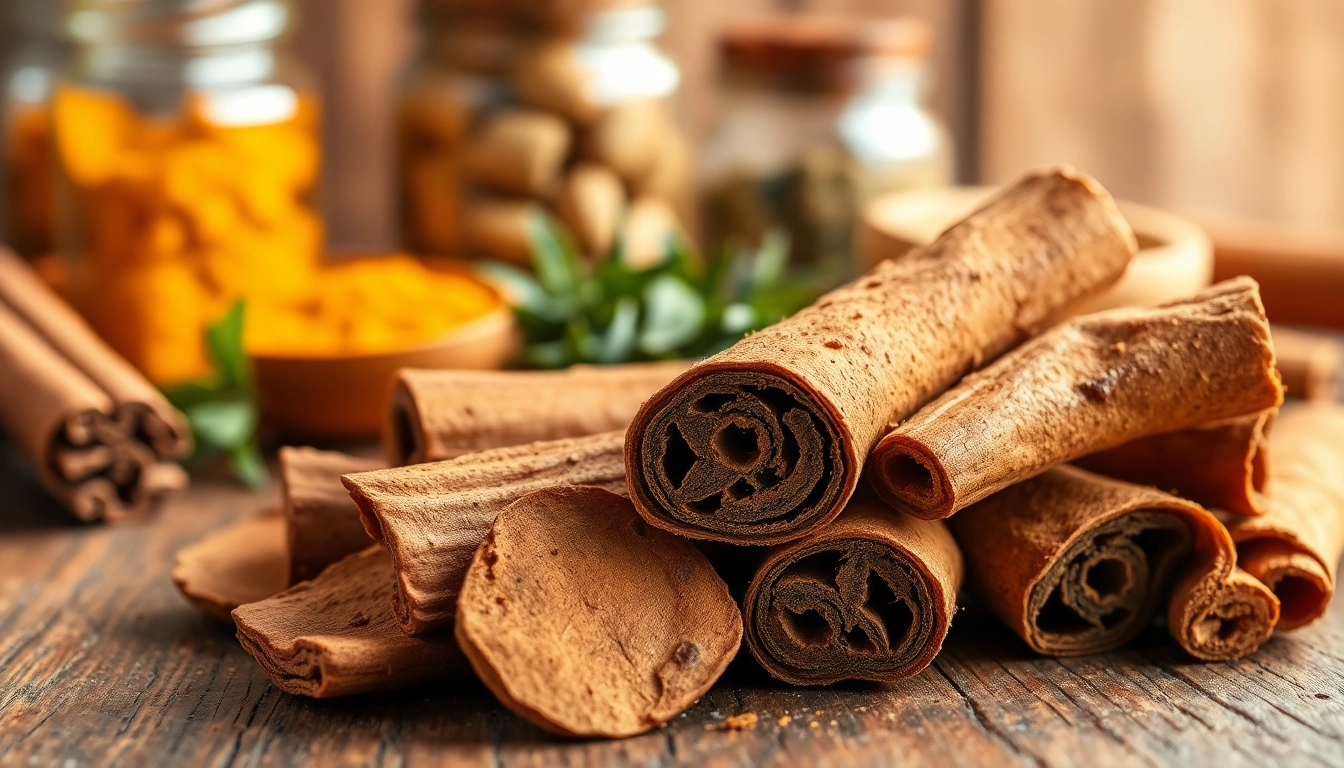1. Understanding Cinnamon Bark
1.1 What is Cinnamon Bark?
Cinnamon bark is derived from the inner bark of trees belonging to the genus Cinnamomum. Preferring humid tropical climates, these trees can be found in various regions, including Southeast Asia, the Caribbean, and South America. The bark is valued not just for its aromatic qualities and flavor enhancement in cooking but also for its medicinal benefits, making it a sought-after natural product globally. The two primary types of cinnamon bark are Ceylon cinnamon and Cassia cinnamon. For an in-depth look at the unique properties and uses of each kind, consider exploring Cinnamon Bark offerings.
1.2 Types of Cinnamon Bark: Ceylon vs. Cassia
Understanding the difference between Ceylon and Cassia cinnamon is crucial, as each variety offers unique flavors and health benefits. Ceylon cinnamon, often referred to as “true cinnamon,” is characterized by its light brown color and delicate, sweet flavor. It contains lower levels of coumarin, a compound that can be harmful in large amounts, making it a safer choice for regular consumption. In contrast, Cassia cinnamon, often darker and bolder, is the more commonly found type in grocery stores. While its flavor is robust and suitable for baking, it contains higher levels of coumarin.
1.3 Nutritional Profile of Cinnamon Bark
Cinnamon bark is not just a flavorful spice; it is also packed with nutrients. A teaspoon of ground cinnamon (approximately 2.6 grams) contains around 6 calories, negligible fat, and carbohydrates. It is high in fiber but low in protein. More importantly, cinnamon is rich in antioxidants, which play a crucial role in combating oxidative stress in the body. Additionally, it contains essential minerals like calcium, manganese, and iron, which are vital for overall health.
2. Health Benefits of Cinnamon Bark
2.1 Antioxidant Properties
One of the standout features of cinnamon bark is its high antioxidant content. Antioxidants such as polyphenols can reduce inflammation and lower the risk of chronic diseases. Studies have demonstrated that cinnamon can outperform several other superfoods in terms of antioxidant ability, making it an invaluable resource in any health-focused diet.
2.2 Cinnamon Bark and Blood Sugar Control
Cinnamon has been widely studied for its effects on blood sugar regulation. Research indicates that it may improve insulin sensitivity and lower blood sugar levels, particularly in individuals with type 2 diabetes. Incorporating cinnamon into meals can lead to more stable blood glucose levels and improved overall diabetes management, showcasing its potential as a supportive dietary inclusion for those dealing with blood sugar issues.
2.3 Digestive Health Benefits of Cinnamon Bark
Many cultures around the world have long employed cinnamon to aid digestion. Its anti-inflammatory properties make it beneficial for those suffering from digestive discomfort, including gas and bloating. Additionally, cinnamon has been shown to potentially combat harmful pathogens in the gut, thereby promoting a healthier microbiome. For these digestive benefits, adding cinnamon to yogurt or smoothies can be particularly effective.
3. Culinary Uses of Cinnamon Bark
3.1 Traditional Dishes Featuring Cinnamon Bark
Cinnamon bark plays a pivotal role in various cuisines, particularly in Southeast Asian and Middle Eastern dishes. From aromatic curries to spiced stews, cinnamon adds depth and warmth to savory meals. In sweet dishes, it is a staple ingredient in baked goods like cinnamon rolls, apple pies, and even various types of chocolates. Its versatility makes it a must-have spice in any kitchen.
3.2 How to Use Cinnamon Bark in Cooking
Using cinnamon bark involves savoring its aromatic quality more than relying on its powdered form. Whole sticks can be infused in liquids such as stocks, teas, or milk, allowing their flavors to permeate. When cooking with cinnamon bark, it’s important to remove it before serving, as the intensity can be quite robust if left. This method retains the delightful aroma without overpowering the dish. It’s also possible to crush the bark into smaller pieces or grind it for specific uses, which invites more flavor during cooking.
3.3 Making Cinnamon Bark Tea and Infusions
Cinnamon bark tea is a delightful way to enjoy the natural benefits of this spice. Simply boil a few sticks of cinnamon in water for several minutes to create an aromatic infusion. For added flavor, consider incorporating ginger, honey, or lemon. This tea can act as a comforting remedy for colds and digestive issues while providing a calming sense of warmth to the body.
4. Medicinal Uses of Cinnamon Bark
4.1 Common Herbal Remedies with Cinnamon Bark
Cinnamon bark has been utilized in various traditional medicine practices due to its array of health benefits. It is acclaimed for its antimicrobial properties, helping to fight infections and promote oral health. Additionally, its anti-spasmodic effect makes cinnamon a common ingredient in herbal formulations for menstrual cramps and gastrointestinal issues.
4.2 Cinnamon Bark in Traditional Medicine
Various ancient traditions, including Chinese and Ayurvedic medicine, have incorporated cinnamon bark for its healing properties. In Traditional Chinese Medicine, it is believed to warm the body, improve circulation, and stimulate digestion. Ayurvedic practitioners utilize it for its supposed ability to balance doshas and alleviate symptoms of cold and flu.
4.3 Safety and Side Effects of Cinnamon Bark
While generally safe for most people, consuming excessive amounts of cinnamon, especially Cassia cinnamon, could lead to adverse effects due to its high coumarin content. Side effects might include liver damage, allergic reactions, or irritation. For individuals taking medications or with existing health conditions, consulting a healthcare professional prior to consuming cinnamon supplements or extracts is advisable.
5. Sourcing and Storing Cinnamon Bark
5.1 How to Pick Quality Cinnamon Bark
When sourcing cinnamon bark, it’s essential to select high-quality products to enjoy its full health benefits and flavors. Look for Ceylon cinnamon when possible, as it is generally regarded as superior due to its lower coumarin levels. Check for a strong fragrance; fresh cinnamon should have a pronounced sweet and spicy aroma. Whole sticks should be clean and smooth, without visible blemishes or excessive powder.
5.2 Storing Cinnamon Bark for Maximum Freshness
To maintain the freshness and potency of cinnamon bark, it should be stored in a cool, dark place in an airtight container. Whole sticks tend to retain their flavor longer than powdered cinnamon, so if possible, opt for the bark form. Stored correctly, cinnamon can last for several years without significant loss of flavor or benefits.
5.3 Environmental Considerations for Cinnamon Bark Supply
As the demand for cinnamon continues to rise, it is vital to consider sustainable sourcing practices. Unsustainable harvesting can lead to deforestation and ecosystem damage. Supporting brands that prioritize sustainable farming and ethical sourcing can help ensure that cinnamon bark remains available for future generations while also preserving biodiversity.



